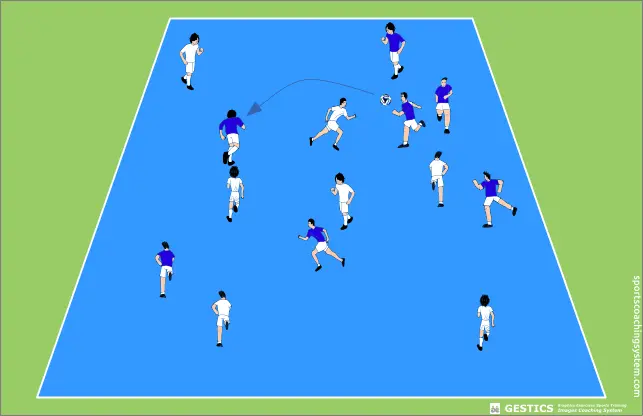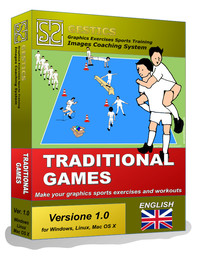MOVEMENT AND SPORTS GAME FOR CHILDREN - No. 0225 - the game of 10 passes

GRAPHICS MADE WITH THE SOFTWAREGESTICS SPORTS
HTTPS://WWW.SPORTSCOACHINGSYSTEM.COM
Type and Action
Typology: movement and sports game for children, exercise ball running games
Goal: basic physical-motor activity
Action: passing, passing, defense, marking
Technical Sheet
Group / Team: in teams
Age: 7-11 years
Training phase: warm-up
Difficulty: easy
Duration: medium (5 to 15 minutes)
Judgment: normal
Short description
try to make 10 consecutive passes between members of the same team, without the players of the other team being able to intercept or touch the ball. Every 10 consecutive passes you get a point
Departure
arranged according to the scheme described, 2 teams, 5 - 8 players per team. The range varies from m. 10x10 up to m. 20x20, according to the number of participants
Execution
the two teams arrange themselves freely for the playing field, which can be a square the size of half the volleyball court (8 - 10 meters per side).
It is important that the components of the teams are easily identifiable (colored bibs, shirts of the same color, strip of colored fabric on the wrist, etc.).
The game consists of trying to make 10 consecutive passes between the members of the same team, without the players of the other team being able to intercept or touch the ball. Every 10 consecutive passes you get a point; the team that reaches 5 points first wins.
If the ball is intercepted by the other team, this in turn begins the count for the 10 passes; if the ball is only touched but remains with the same team, the count must start from zero. Each time a correct pass is made, the receiver of the ball says aloud the number of the pass he is making, so that everyone is aware of the total number of passes made. If whoever has the ball suffers a foul (push, pull, etc.) this is punished in any case with the attribution of 3 more passes to the opposing team.
Variants
Whoever is in possession of the ball must remain stationary in place and can only pass
Whoever is in possession of the ball can only move around the court if he is dribbling on the ground like basketball
Depending on the age and abilities of the participants, the number of steps can be varied: 5, 7 or 10
Advice
If you realize that they are always the same ones who pass the ball, you can say that you can't make the "return pass", that is, I can't give the ball back to whoever gave it to me.
Materials
A volleyball or a light ball;
Any handkerchiefs or strips of colored cloth to distinguish the two teams.

 Español (ES)
Español (ES)  Português (PT)
Português (PT)  Italiano (IT)
Italiano (IT)  Deutsch (DE)
Deutsch (DE)  Français (FR)
Français (FR)  English (EN)
English (EN) 